7207MKT: Blood Donation Behavior in Australia Report
VerifiedAdded on 2021/05/12
|11
|3241
|171
Report
AI Summary
This report, prepared by Aruzhan Jakanova for the 7207MKT course, investigates the critical issue of blood donation shortages in Australia and globally. It begins with an introduction emphasizing the vital role of blood transfusions and the challenges faced by healthcare systems in maintaining adequate blood supplies. A comprehensive literature review follows, exploring blood donation motivators, obstacles, and cultural and demographic issues affecting donor behavior. The report examines models such as the Volunteer Process Model (VPM) and the work of Godin, highlighting the role of altruism, social influence, and satisfaction in motivating donors. Obstacles such as fear, anxiety, and lack of information are discussed, along with demographic disparities and cultural sensitivities that impact donation rates. The report also presents research objectives and hypotheses, aiming to determine motivators across generations, explore donation challenges, and analyze behavioral patterns. The report concludes by summarizing key findings and suggesting areas for further research to address blood donation shortages effectively.
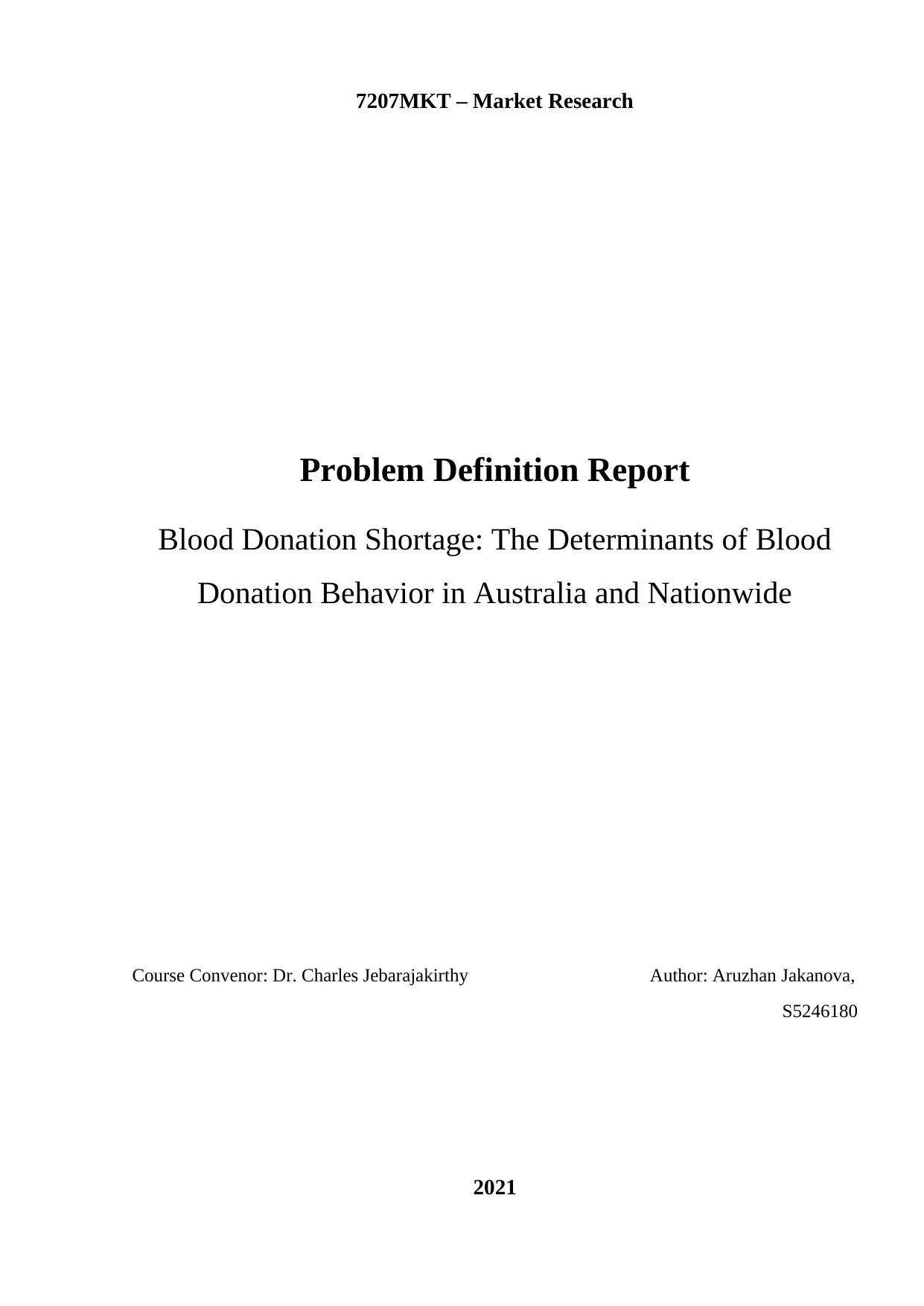
7207MKT – Market Research
Problem Definition Report
Blood Donation Shortage: The Determinants of Blood
Donation Behavior in Australia and Nationwide
Course Convenor: Dr. Charles Jebarajakirthy Author: Aruzhan Jakanova,
S5246180
2021
Problem Definition Report
Blood Donation Shortage: The Determinants of Blood
Donation Behavior in Australia and Nationwide
Course Convenor: Dr. Charles Jebarajakirthy Author: Aruzhan Jakanova,
S5246180
2021
Paraphrase This Document
Need a fresh take? Get an instant paraphrase of this document with our AI Paraphraser

Contents
Introduction.....................................................................................................................................3
1. Literature Review........................................................................................................................5
1.1 Blood Donation Motivators.......................................................................................................5
1.2 Blood Donation Obstacles.........................................................................................................6
1.3 Cultural and Demographic Issues Affecting Blood Donation Behavior...................................7
References.......................................................................................................................................8
2
Introduction.....................................................................................................................................3
1. Literature Review........................................................................................................................5
1.1 Blood Donation Motivators.......................................................................................................5
1.2 Blood Donation Obstacles.........................................................................................................6
1.3 Cultural and Demographic Issues Affecting Blood Donation Behavior...................................7
References.......................................................................................................................................8
2
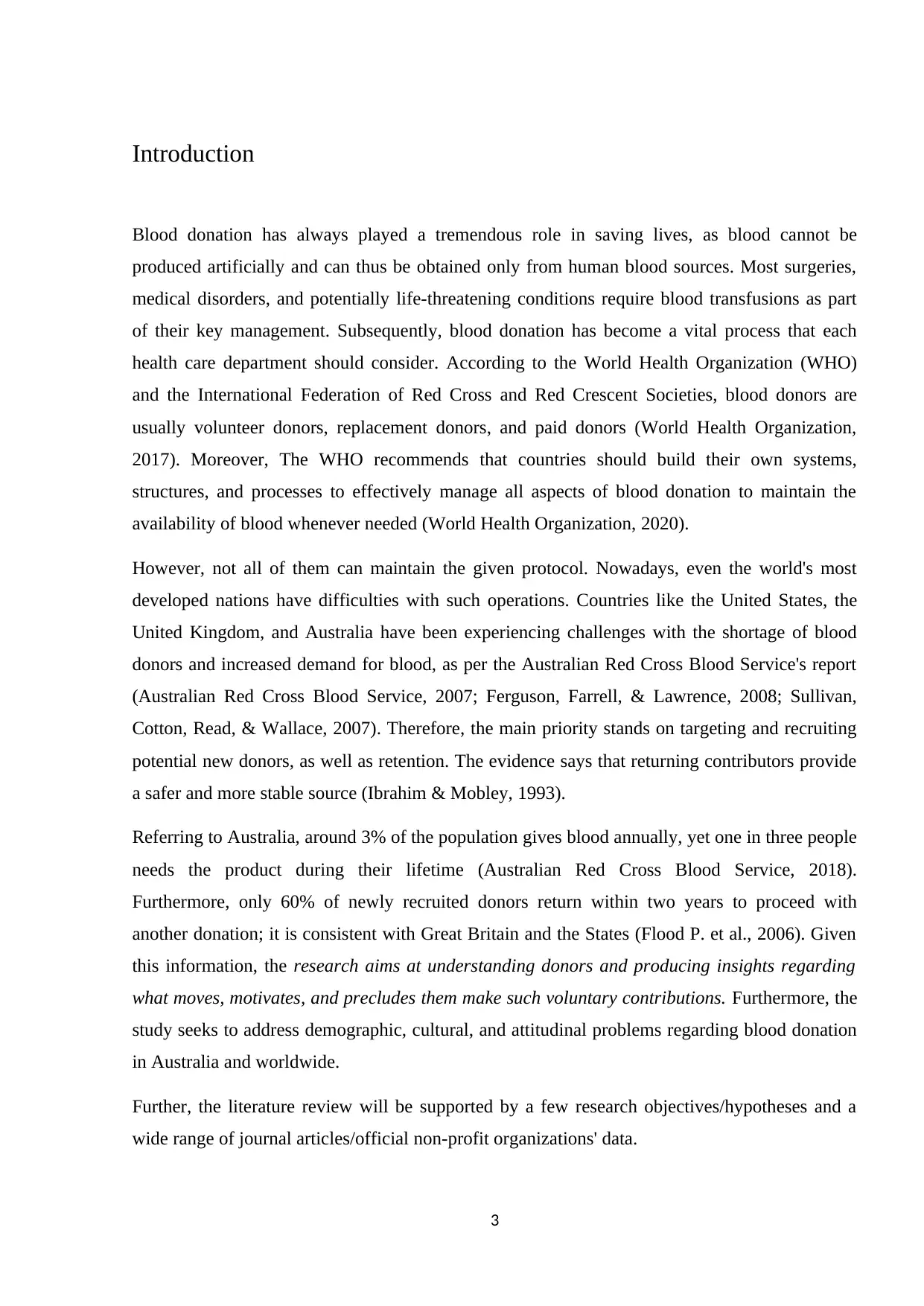
Introduction
Blood donation has always played a tremendous role in saving lives, as blood cannot be
produced artificially and can thus be obtained only from human blood sources. Most surgeries,
medical disorders, and potentially life-threatening conditions require blood transfusions as part
of their key management. Subsequently, blood donation has become a vital process that each
health care department should consider. According to the World Health Organization (WHO)
and the International Federation of Red Cross and Red Crescent Societies, blood donors are
usually volunteer donors, replacement donors, and paid donors (World Health Organization,
2017). Moreover, The WHO recommends that countries should build their own systems,
structures, and processes to effectively manage all aspects of blood donation to maintain the
availability of blood whenever needed (World Health Organization, 2020).
However, not all of them can maintain the given protocol. Nowadays, even the world's most
developed nations have difficulties with such operations. Countries like the United States, the
United Kingdom, and Australia have been experiencing challenges with the shortage of blood
donors and increased demand for blood, as per the Australian Red Cross Blood Service's report
(Australian Red Cross Blood Service, 2007; Ferguson, Farrell, & Lawrence, 2008; Sullivan,
Cotton, Read, & Wallace, 2007). Therefore, the main priority stands on targeting and recruiting
potential new donors, as well as retention. The evidence says that returning contributors provide
a safer and more stable source (Ibrahim & Mobley, 1993).
Referring to Australia, around 3% of the population gives blood annually, yet one in three people
needs the product during their lifetime (Australian Red Cross Blood Service, 2018).
Furthermore, only 60% of newly recruited donors return within two years to proceed with
another donation; it is consistent with Great Britain and the States (Flood P. et al., 2006). Given
this information, the research aims at understanding donors and producing insights regarding
what moves, motivates, and precludes them make such voluntary contributions. Furthermore, the
study seeks to address demographic, cultural, and attitudinal problems regarding blood donation
in Australia and worldwide.
Further, the literature review will be supported by a few research objectives/hypotheses and a
wide range of journal articles/official non-profit organizations' data.
3
Blood donation has always played a tremendous role in saving lives, as blood cannot be
produced artificially and can thus be obtained only from human blood sources. Most surgeries,
medical disorders, and potentially life-threatening conditions require blood transfusions as part
of their key management. Subsequently, blood donation has become a vital process that each
health care department should consider. According to the World Health Organization (WHO)
and the International Federation of Red Cross and Red Crescent Societies, blood donors are
usually volunteer donors, replacement donors, and paid donors (World Health Organization,
2017). Moreover, The WHO recommends that countries should build their own systems,
structures, and processes to effectively manage all aspects of blood donation to maintain the
availability of blood whenever needed (World Health Organization, 2020).
However, not all of them can maintain the given protocol. Nowadays, even the world's most
developed nations have difficulties with such operations. Countries like the United States, the
United Kingdom, and Australia have been experiencing challenges with the shortage of blood
donors and increased demand for blood, as per the Australian Red Cross Blood Service's report
(Australian Red Cross Blood Service, 2007; Ferguson, Farrell, & Lawrence, 2008; Sullivan,
Cotton, Read, & Wallace, 2007). Therefore, the main priority stands on targeting and recruiting
potential new donors, as well as retention. The evidence says that returning contributors provide
a safer and more stable source (Ibrahim & Mobley, 1993).
Referring to Australia, around 3% of the population gives blood annually, yet one in three people
needs the product during their lifetime (Australian Red Cross Blood Service, 2018).
Furthermore, only 60% of newly recruited donors return within two years to proceed with
another donation; it is consistent with Great Britain and the States (Flood P. et al., 2006). Given
this information, the research aims at understanding donors and producing insights regarding
what moves, motivates, and precludes them make such voluntary contributions. Furthermore, the
study seeks to address demographic, cultural, and attitudinal problems regarding blood donation
in Australia and worldwide.
Further, the literature review will be supported by a few research objectives/hypotheses and a
wide range of journal articles/official non-profit organizations' data.
3
⊘ This is a preview!⊘
Do you want full access?
Subscribe today to unlock all pages.

Trusted by 1+ million students worldwide
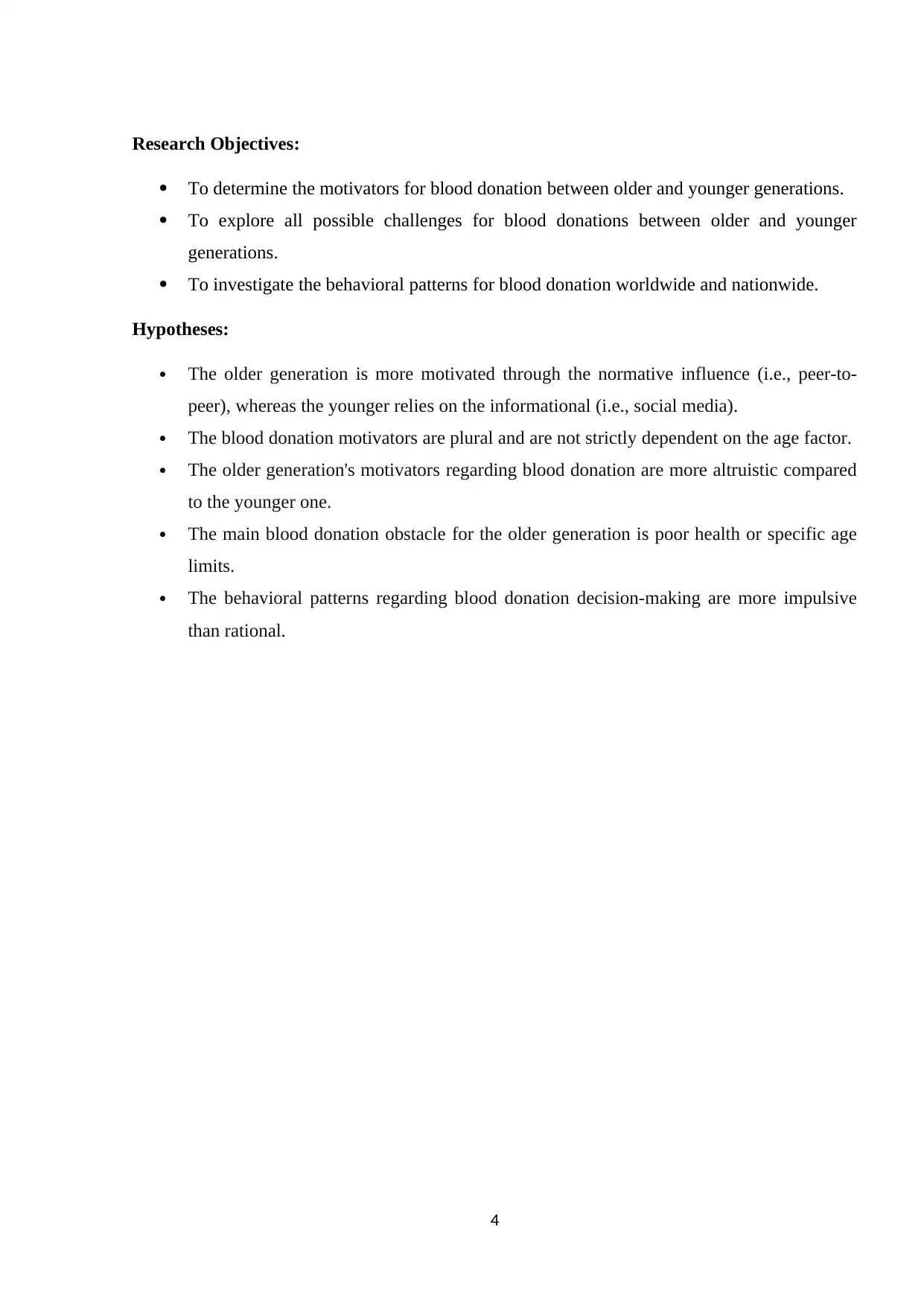
Research Objectives:
To determine the motivators for blood donation between older and younger generations.
To explore all possible challenges for blood donations between older and younger
generations.
To investigate the behavioral patterns for blood donation worldwide and nationwide.
Hypotheses:
The older generation is more motivated through the normative influence (i.e., peer-to-
peer), whereas the younger relies on the informational (i.e., social media).
The blood donation motivators are plural and are not strictly dependent on the age factor.
The older generation's motivators regarding blood donation are more altruistic compared
to the younger one.
The main blood donation obstacle for the older generation is poor health or specific age
limits.
The behavioral patterns regarding blood donation decision-making are more impulsive
than rational.
4
To determine the motivators for blood donation between older and younger generations.
To explore all possible challenges for blood donations between older and younger
generations.
To investigate the behavioral patterns for blood donation worldwide and nationwide.
Hypotheses:
The older generation is more motivated through the normative influence (i.e., peer-to-
peer), whereas the younger relies on the informational (i.e., social media).
The blood donation motivators are plural and are not strictly dependent on the age factor.
The older generation's motivators regarding blood donation are more altruistic compared
to the younger one.
The main blood donation obstacle for the older generation is poor health or specific age
limits.
The behavioral patterns regarding blood donation decision-making are more impulsive
than rational.
4
Paraphrase This Document
Need a fresh take? Get an instant paraphrase of this document with our AI Paraphraser
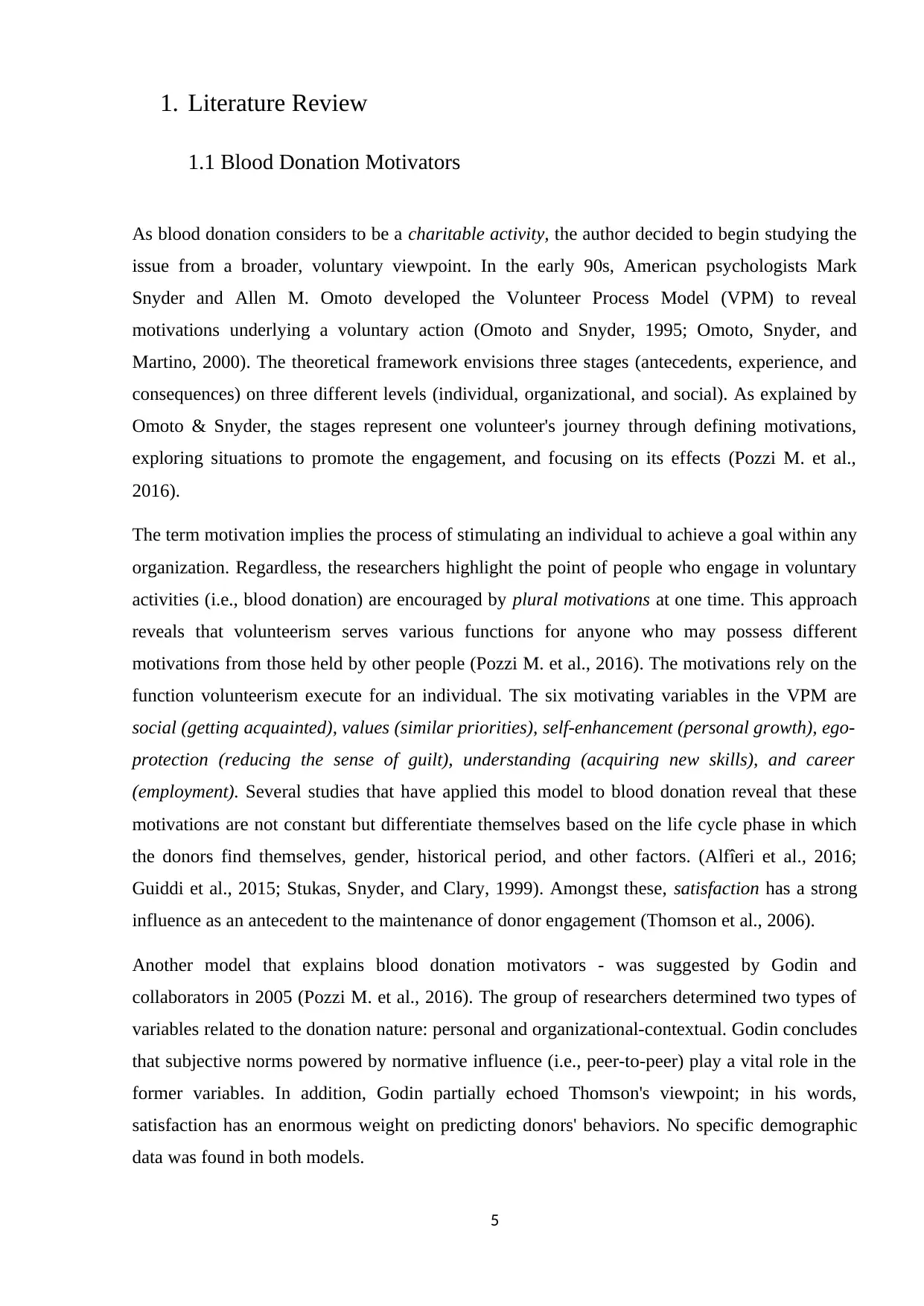
1. Literature Review
1.1 Blood Donation Motivators
As blood donation considers to be a charitable activity, the author decided to begin studying the
issue from a broader, voluntary viewpoint. In the early 90s, American psychologists Mark
Snyder and Allen M. Omoto developed the Volunteer Process Model (VPM) to reveal
motivations underlying a voluntary action (Omoto and Snyder, 1995; Omoto, Snyder, and
Martino, 2000). The theoretical framework envisions three stages (antecedents, experience, and
consequences) on three different levels (individual, organizational, and social). As explained by
Omoto & Snyder, the stages represent one volunteer's journey through defining motivations,
exploring situations to promote the engagement, and focusing on its effects (Pozzi M. et al.,
2016).
The term motivation implies the process of stimulating an individual to achieve a goal within any
organization. Regardless, the researchers highlight the point of people who engage in voluntary
activities (i.e., blood donation) are encouraged by plural motivations at one time. This approach
reveals that volunteerism serves various functions for anyone who may possess different
motivations from those held by other people (Pozzi M. et al., 2016). The motivations rely on the
function volunteerism execute for an individual. The six motivating variables in the VPM are
social (getting acquainted), values (similar priorities), self-enhancement (personal growth), ego-
protection (reducing the sense of guilt), understanding (acquiring new skills), and career
(employment). Several studies that have applied this model to blood donation reveal that these
motivations are not constant but differentiate themselves based on the life cycle phase in which
the donors find themselves, gender, historical period, and other factors. (Alfîeri et al., 2016;
Guiddi et al., 2015; Stukas, Snyder, and Clary, 1999). Amongst these, satisfaction has a strong
influence as an antecedent to the maintenance of donor engagement (Thomson et al., 2006).
Another model that explains blood donation motivators - was suggested by Godin and
collaborators in 2005 (Pozzi M. et al., 2016). The group of researchers determined two types of
variables related to the donation nature: personal and organizational-contextual. Godin concludes
that subjective norms powered by normative influence (i.e., peer-to-peer) play a vital role in the
former variables. In addition, Godin partially echoed Thomson's viewpoint; in his words,
satisfaction has an enormous weight on predicting donors' behaviors. No specific demographic
data was found in both models.
5
1.1 Blood Donation Motivators
As blood donation considers to be a charitable activity, the author decided to begin studying the
issue from a broader, voluntary viewpoint. In the early 90s, American psychologists Mark
Snyder and Allen M. Omoto developed the Volunteer Process Model (VPM) to reveal
motivations underlying a voluntary action (Omoto and Snyder, 1995; Omoto, Snyder, and
Martino, 2000). The theoretical framework envisions three stages (antecedents, experience, and
consequences) on three different levels (individual, organizational, and social). As explained by
Omoto & Snyder, the stages represent one volunteer's journey through defining motivations,
exploring situations to promote the engagement, and focusing on its effects (Pozzi M. et al.,
2016).
The term motivation implies the process of stimulating an individual to achieve a goal within any
organization. Regardless, the researchers highlight the point of people who engage in voluntary
activities (i.e., blood donation) are encouraged by plural motivations at one time. This approach
reveals that volunteerism serves various functions for anyone who may possess different
motivations from those held by other people (Pozzi M. et al., 2016). The motivations rely on the
function volunteerism execute for an individual. The six motivating variables in the VPM are
social (getting acquainted), values (similar priorities), self-enhancement (personal growth), ego-
protection (reducing the sense of guilt), understanding (acquiring new skills), and career
(employment). Several studies that have applied this model to blood donation reveal that these
motivations are not constant but differentiate themselves based on the life cycle phase in which
the donors find themselves, gender, historical period, and other factors. (Alfîeri et al., 2016;
Guiddi et al., 2015; Stukas, Snyder, and Clary, 1999). Amongst these, satisfaction has a strong
influence as an antecedent to the maintenance of donor engagement (Thomson et al., 2006).
Another model that explains blood donation motivators - was suggested by Godin and
collaborators in 2005 (Pozzi M. et al., 2016). The group of researchers determined two types of
variables related to the donation nature: personal and organizational-contextual. Godin concludes
that subjective norms powered by normative influence (i.e., peer-to-peer) play a vital role in the
former variables. In addition, Godin partially echoed Thomson's viewpoint; in his words,
satisfaction has an enormous weight on predicting donors' behaviors. No specific demographic
data was found in both models.
5
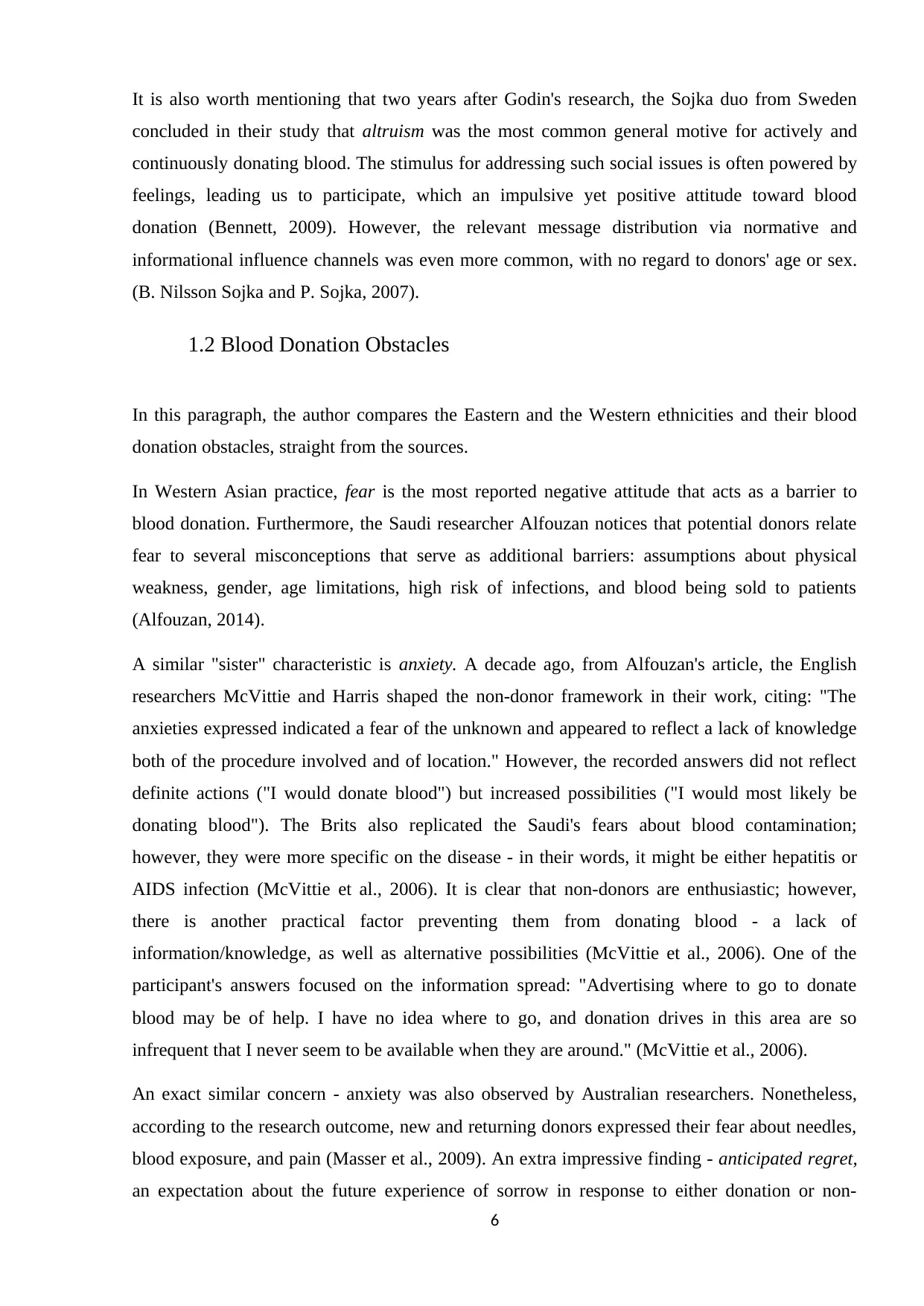
It is also worth mentioning that two years after Godin's research, the Sojka duo from Sweden
concluded in their study that altruism was the most common general motive for actively and
continuously donating blood. The stimulus for addressing such social issues is often powered by
feelings, leading us to participate, which an impulsive yet positive attitude toward blood
donation (Bennett, 2009). However, the relevant message distribution via normative and
informational influence channels was even more common, with no regard to donors' age or sex.
(B. Nilsson Sojka and P. Sojka, 2007).
1.2 Blood Donation Obstacles
In this paragraph, the author compares the Eastern and the Western ethnicities and their blood
donation obstacles, straight from the sources.
In Western Asian practice, fear is the most reported negative attitude that acts as a barrier to
blood donation. Furthermore, the Saudi researcher Alfouzan notices that potential donors relate
fear to several misconceptions that serve as additional barriers: assumptions about physical
weakness, gender, age limitations, high risk of infections, and blood being sold to patients
(Alfouzan, 2014).
A similar "sister" characteristic is anxiety. A decade ago, from Alfouzan's article, the English
researchers McVittie and Harris shaped the non-donor framework in their work, citing: "The
anxieties expressed indicated a fear of the unknown and appeared to reflect a lack of knowledge
both of the procedure involved and of location." However, the recorded answers did not reflect
definite actions ("I would donate blood") but increased possibilities ("I would most likely be
donating blood"). The Brits also replicated the Saudi's fears about blood contamination;
however, they were more specific on the disease - in their words, it might be either hepatitis or
AIDS infection (McVittie et al., 2006). It is clear that non-donors are enthusiastic; however,
there is another practical factor preventing them from donating blood - a lack of
information/knowledge, as well as alternative possibilities (McVittie et al., 2006). One of the
participant's answers focused on the information spread: "Advertising where to go to donate
blood may be of help. I have no idea where to go, and donation drives in this area are so
infrequent that I never seem to be available when they are around." (McVittie et al., 2006).
An exact similar concern - anxiety was also observed by Australian researchers. Nonetheless,
according to the research outcome, new and returning donors expressed their fear about needles,
blood exposure, and pain (Masser et al., 2009). An extra impressive finding - anticipated regret,
an expectation about the future experience of sorrow in response to either donation or non-
6
concluded in their study that altruism was the most common general motive for actively and
continuously donating blood. The stimulus for addressing such social issues is often powered by
feelings, leading us to participate, which an impulsive yet positive attitude toward blood
donation (Bennett, 2009). However, the relevant message distribution via normative and
informational influence channels was even more common, with no regard to donors' age or sex.
(B. Nilsson Sojka and P. Sojka, 2007).
1.2 Blood Donation Obstacles
In this paragraph, the author compares the Eastern and the Western ethnicities and their blood
donation obstacles, straight from the sources.
In Western Asian practice, fear is the most reported negative attitude that acts as a barrier to
blood donation. Furthermore, the Saudi researcher Alfouzan notices that potential donors relate
fear to several misconceptions that serve as additional barriers: assumptions about physical
weakness, gender, age limitations, high risk of infections, and blood being sold to patients
(Alfouzan, 2014).
A similar "sister" characteristic is anxiety. A decade ago, from Alfouzan's article, the English
researchers McVittie and Harris shaped the non-donor framework in their work, citing: "The
anxieties expressed indicated a fear of the unknown and appeared to reflect a lack of knowledge
both of the procedure involved and of location." However, the recorded answers did not reflect
definite actions ("I would donate blood") but increased possibilities ("I would most likely be
donating blood"). The Brits also replicated the Saudi's fears about blood contamination;
however, they were more specific on the disease - in their words, it might be either hepatitis or
AIDS infection (McVittie et al., 2006). It is clear that non-donors are enthusiastic; however,
there is another practical factor preventing them from donating blood - a lack of
information/knowledge, as well as alternative possibilities (McVittie et al., 2006). One of the
participant's answers focused on the information spread: "Advertising where to go to donate
blood may be of help. I have no idea where to go, and donation drives in this area are so
infrequent that I never seem to be available when they are around." (McVittie et al., 2006).
An exact similar concern - anxiety was also observed by Australian researchers. Nonetheless,
according to the research outcome, new and returning donors expressed their fear about needles,
blood exposure, and pain (Masser et al., 2009). An extra impressive finding - anticipated regret,
an expectation about the future experience of sorrow in response to either donation or non-
6
⊘ This is a preview!⊘
Do you want full access?
Subscribe today to unlock all pages.

Trusted by 1+ million students worldwide
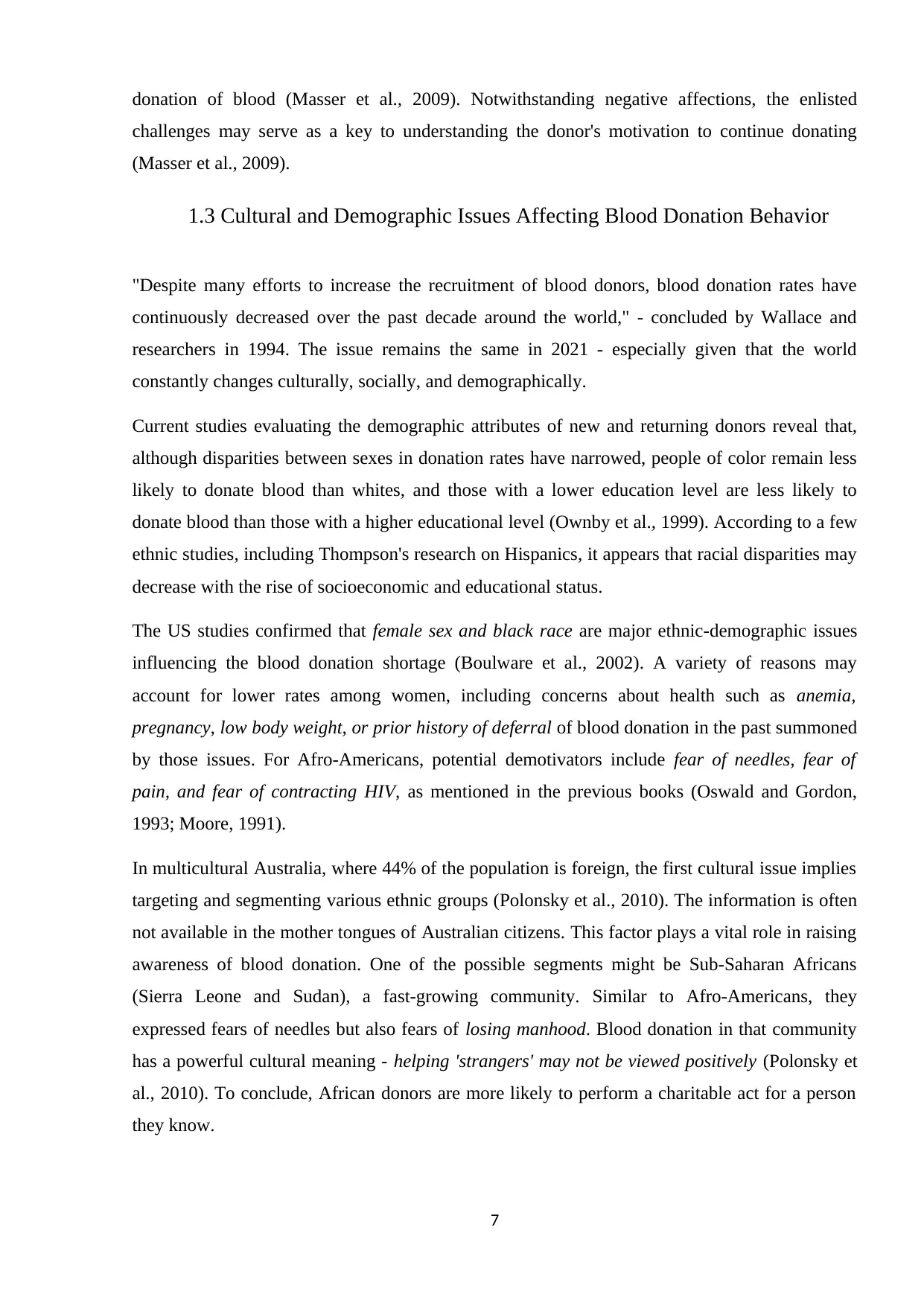
donation of blood (Masser et al., 2009). Notwithstanding negative affections, the enlisted
challenges may serve as a key to understanding the donor's motivation to continue donating
(Masser et al., 2009).
1.3 Cultural and Demographic Issues Affecting Blood Donation Behavior
"Despite many efforts to increase the recruitment of blood donors, blood donation rates have
continuously decreased over the past decade around the world," - concluded by Wallace and
researchers in 1994. The issue remains the same in 2021 - especially given that the world
constantly changes culturally, socially, and demographically.
Current studies evaluating the demographic attributes of new and returning donors reveal that,
although disparities between sexes in donation rates have narrowed, people of color remain less
likely to donate blood than whites, and those with a lower education level are less likely to
donate blood than those with a higher educational level (Ownby et al., 1999). According to a few
ethnic studies, including Thompson's research on Hispanics, it appears that racial disparities may
decrease with the rise of socioeconomic and educational status.
The US studies confirmed that female sex and black race are major ethnic-demographic issues
influencing the blood donation shortage (Boulware et al., 2002). A variety of reasons may
account for lower rates among women, including concerns about health such as anemia,
pregnancy, low body weight, or prior history of deferral of blood donation in the past summoned
by those issues. For Afro-Americans, potential demotivators include fear of needles, fear of
pain, and fear of contracting HIV, as mentioned in the previous books (Oswald and Gordon,
1993; Moore, 1991).
In multicultural Australia, where 44% of the population is foreign, the first cultural issue implies
targeting and segmenting various ethnic groups (Polonsky et al., 2010). The information is often
not available in the mother tongues of Australian citizens. This factor plays a vital role in raising
awareness of blood donation. One of the possible segments might be Sub-Saharan Africans
(Sierra Leone and Sudan), a fast-growing community. Similar to Afro-Americans, they
expressed fears of needles but also fears of losing manhood. Blood donation in that community
has a powerful cultural meaning - helping 'strangers' may not be viewed positively (Polonsky et
al., 2010). To conclude, African donors are more likely to perform a charitable act for a person
they know.
7
challenges may serve as a key to understanding the donor's motivation to continue donating
(Masser et al., 2009).
1.3 Cultural and Demographic Issues Affecting Blood Donation Behavior
"Despite many efforts to increase the recruitment of blood donors, blood donation rates have
continuously decreased over the past decade around the world," - concluded by Wallace and
researchers in 1994. The issue remains the same in 2021 - especially given that the world
constantly changes culturally, socially, and demographically.
Current studies evaluating the demographic attributes of new and returning donors reveal that,
although disparities between sexes in donation rates have narrowed, people of color remain less
likely to donate blood than whites, and those with a lower education level are less likely to
donate blood than those with a higher educational level (Ownby et al., 1999). According to a few
ethnic studies, including Thompson's research on Hispanics, it appears that racial disparities may
decrease with the rise of socioeconomic and educational status.
The US studies confirmed that female sex and black race are major ethnic-demographic issues
influencing the blood donation shortage (Boulware et al., 2002). A variety of reasons may
account for lower rates among women, including concerns about health such as anemia,
pregnancy, low body weight, or prior history of deferral of blood donation in the past summoned
by those issues. For Afro-Americans, potential demotivators include fear of needles, fear of
pain, and fear of contracting HIV, as mentioned in the previous books (Oswald and Gordon,
1993; Moore, 1991).
In multicultural Australia, where 44% of the population is foreign, the first cultural issue implies
targeting and segmenting various ethnic groups (Polonsky et al., 2010). The information is often
not available in the mother tongues of Australian citizens. This factor plays a vital role in raising
awareness of blood donation. One of the possible segments might be Sub-Saharan Africans
(Sierra Leone and Sudan), a fast-growing community. Similar to Afro-Americans, they
expressed fears of needles but also fears of losing manhood. Blood donation in that community
has a powerful cultural meaning - helping 'strangers' may not be viewed positively (Polonsky et
al., 2010). To conclude, African donors are more likely to perform a charitable act for a person
they know.
7
Paraphrase This Document
Need a fresh take? Get an instant paraphrase of this document with our AI Paraphraser
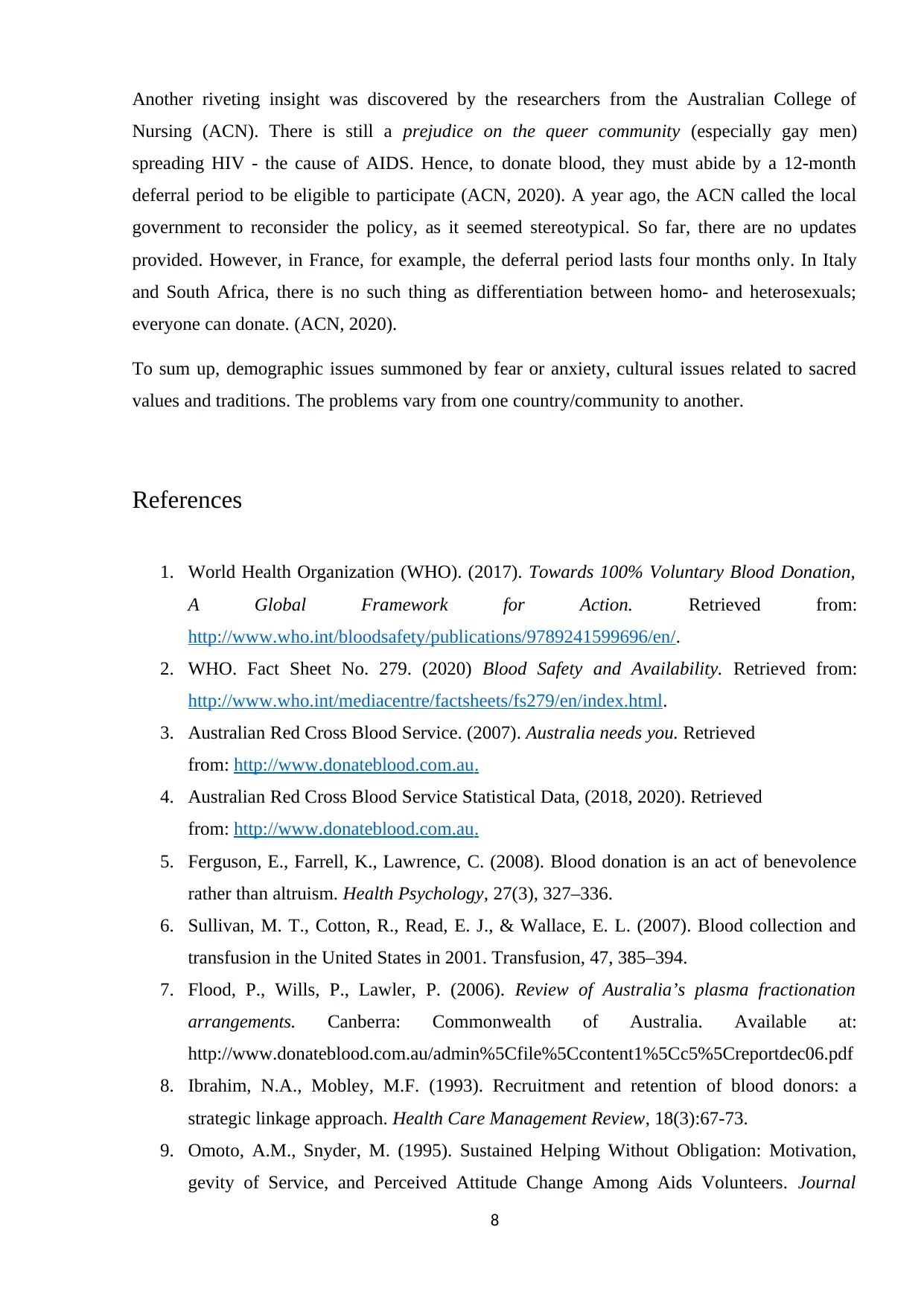
Another riveting insight was discovered by the researchers from the Australian College of
Nursing (ACN). There is still a prejudice on the queer community (especially gay men)
spreading HIV - the cause of AIDS. Hence, to donate blood, they must abide by a 12-month
deferral period to be eligible to participate (ACN, 2020). A year ago, the ACN called the local
government to reconsider the policy, as it seemed stereotypical. So far, there are no updates
provided. However, in France, for example, the deferral period lasts four months only. In Italy
and South Africa, there is no such thing as differentiation between homo- and heterosexuals;
everyone can donate. (ACN, 2020).
To sum up, demographic issues summoned by fear or anxiety, cultural issues related to sacred
values and traditions. The problems vary from one country/community to another.
References
1. World Health Organization (WHO). (2017). Towards 100% Voluntary Blood Donation,
A Global Framework for Action. Retrieved from:
http://www.who.int/bloodsafety/publications/9789241599696/en/.
2. WHO. Fact Sheet No. 279. (2020) Blood Safety and Availability. Retrieved from:
http://www.who.int/mediacentre/factsheets/fs279/en/index.html.
3. Australian Red Cross Blood Service. (2007). Australia needs you. Retrieved
from: http://www.donateblood.com.au.
4. Australian Red Cross Blood Service Statistical Data, (2018, 2020). Retrieved
from: http://www.donateblood.com.au.
5. Ferguson, E., Farrell, K., Lawrence, C. (2008). Blood donation is an act of benevolence
rather than altruism. Health Psychology, 27(3), 327–336.
6. Sullivan, M. T., Cotton, R., Read, E. J., & Wallace, E. L. (2007). Blood collection and
transfusion in the United States in 2001. Transfusion, 47, 385–394.
7. Flood, P., Wills, P., Lawler, P. (2006). Review of Australia’s plasma fractionation
arrangements. Canberra: Commonwealth of Australia. Available at:
http://www.donateblood.com.au/admin%5Cfile%5Ccontent1%5Cc5%5Creportdec06.pdf
8. Ibrahim, N.A., Mobley, M.F. (1993). Recruitment and retention of blood donors: a
strategic linkage approach. Health Care Management Review, 18(3):67-73.
9. Omoto, A.M., Snyder, M. (1995). Sustained Helping Without Obligation: Motivation,
gevity of Service, and Perceived Attitude Change Among Aids Volunteers. Journal
8
Nursing (ACN). There is still a prejudice on the queer community (especially gay men)
spreading HIV - the cause of AIDS. Hence, to donate blood, they must abide by a 12-month
deferral period to be eligible to participate (ACN, 2020). A year ago, the ACN called the local
government to reconsider the policy, as it seemed stereotypical. So far, there are no updates
provided. However, in France, for example, the deferral period lasts four months only. In Italy
and South Africa, there is no such thing as differentiation between homo- and heterosexuals;
everyone can donate. (ACN, 2020).
To sum up, demographic issues summoned by fear or anxiety, cultural issues related to sacred
values and traditions. The problems vary from one country/community to another.
References
1. World Health Organization (WHO). (2017). Towards 100% Voluntary Blood Donation,
A Global Framework for Action. Retrieved from:
http://www.who.int/bloodsafety/publications/9789241599696/en/.
2. WHO. Fact Sheet No. 279. (2020) Blood Safety and Availability. Retrieved from:
http://www.who.int/mediacentre/factsheets/fs279/en/index.html.
3. Australian Red Cross Blood Service. (2007). Australia needs you. Retrieved
from: http://www.donateblood.com.au.
4. Australian Red Cross Blood Service Statistical Data, (2018, 2020). Retrieved
from: http://www.donateblood.com.au.
5. Ferguson, E., Farrell, K., Lawrence, C. (2008). Blood donation is an act of benevolence
rather than altruism. Health Psychology, 27(3), 327–336.
6. Sullivan, M. T., Cotton, R., Read, E. J., & Wallace, E. L. (2007). Blood collection and
transfusion in the United States in 2001. Transfusion, 47, 385–394.
7. Flood, P., Wills, P., Lawler, P. (2006). Review of Australia’s plasma fractionation
arrangements. Canberra: Commonwealth of Australia. Available at:
http://www.donateblood.com.au/admin%5Cfile%5Ccontent1%5Cc5%5Creportdec06.pdf
8. Ibrahim, N.A., Mobley, M.F. (1993). Recruitment and retention of blood donors: a
strategic linkage approach. Health Care Management Review, 18(3):67-73.
9. Omoto, A.M., Snyder, M. (1995). Sustained Helping Without Obligation: Motivation,
gevity of Service, and Perceived Attitude Change Among Aids Volunteers. Journal
8
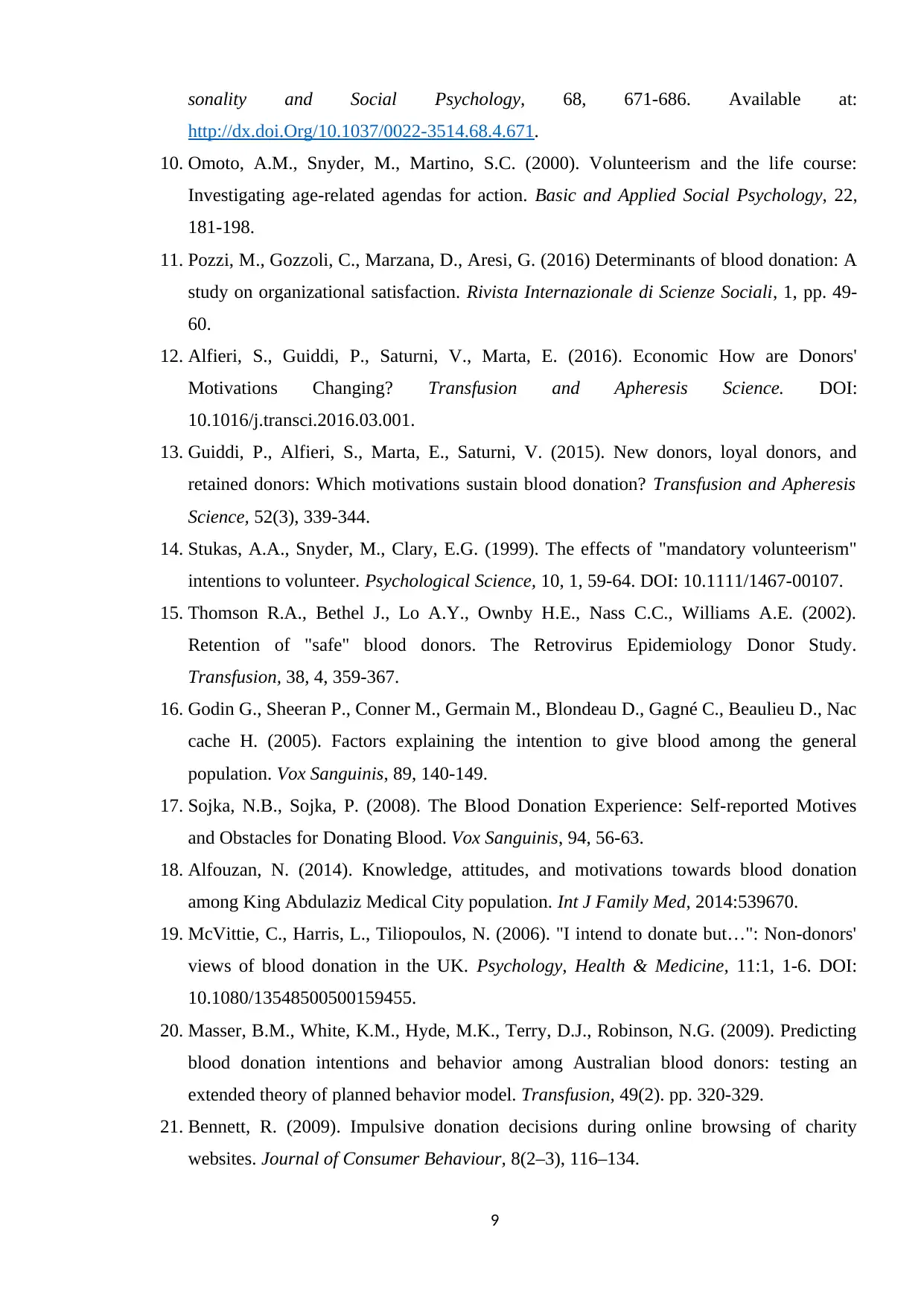
sonality and Social Psychology, 68, 671-686. Available at:
http://dx.doi.Org/10.1037/0022-3514.68.4.671.
10. Omoto, A.M., Snyder, M., Martino, S.C. (2000). Volunteerism and the life course:
Investigating age-related agendas for action. Basic and Applied Social Psychology, 22,
181-198.
11. Pozzi, M., Gozzoli, C., Marzana, D., Aresi, G. (2016) Determinants of blood donation: A
study on organizational satisfaction. Rivista Internazionale di Scienze Sociali, 1, pp. 49-
60.
12. Alfieri, S., Guiddi, P., Saturni, V., Marta, E. (2016). Economic How are Donors'
Motivations Changing? Transfusion and Apheresis Science. DOI:
10.1016/j.transci.2016.03.001.
13. Guiddi, P., Alfieri, S., Marta, E., Saturni, V. (2015). New donors, loyal donors, and
retained donors: Which motivations sustain blood donation? Transfusion and Apheresis
Science, 52(3), 339-344.
14. Stukas, A.A., Snyder, M., Clary, E.G. (1999). The effects of "mandatory volunteerism"
intentions to volunteer. Psychological Science, 10, 1, 59-64. DOI: 10.1111/1467-00107.
15. Thomson R.A., Bethel J., Lo A.Y., Ownby H.E., Nass C.C., Williams A.E. (2002).
Retention of "safe" blood donors. The Retrovirus Epidemiology Donor Study.
Transfusion, 38, 4, 359-367.
16. Godin G., Sheeran P., Conner M., Germain M., Blondeau D., Gagné C., Beaulieu D., Nac
cache H. (2005). Factors explaining the intention to give blood among the general
population. Vox Sanguinis, 89, 140-149.
17. Sojka, N.B., Sojka, P. (2008). The Blood Donation Experience: Self-reported Motives
and Obstacles for Donating Blood. Vox Sanguinis, 94, 56-63.
18. Alfouzan, N. (2014). Knowledge, attitudes, and motivations towards blood donation
among King Abdulaziz Medical City population. Int J Family Med, 2014:539670.
19. McVittie, C., Harris, L., Tiliopoulos, N. (2006). "I intend to donate but…": Non-donors'
views of blood donation in the UK. Psychology, Health & Medicine, 11:1, 1-6. DOI:
10.1080/13548500500159455.
20. Masser, B.M., White, K.M., Hyde, M.K., Terry, D.J., Robinson, N.G. (2009). Predicting
blood donation intentions and behavior among Australian blood donors: testing an
extended theory of planned behavior model. Transfusion, 49(2). pp. 320-329.
21. Bennett, R. (2009). Impulsive donation decisions during online browsing of charity
websites. Journal of Consumer Behaviour, 8(2–3), 116–134.
9
http://dx.doi.Org/10.1037/0022-3514.68.4.671.
10. Omoto, A.M., Snyder, M., Martino, S.C. (2000). Volunteerism and the life course:
Investigating age-related agendas for action. Basic and Applied Social Psychology, 22,
181-198.
11. Pozzi, M., Gozzoli, C., Marzana, D., Aresi, G. (2016) Determinants of blood donation: A
study on organizational satisfaction. Rivista Internazionale di Scienze Sociali, 1, pp. 49-
60.
12. Alfieri, S., Guiddi, P., Saturni, V., Marta, E. (2016). Economic How are Donors'
Motivations Changing? Transfusion and Apheresis Science. DOI:
10.1016/j.transci.2016.03.001.
13. Guiddi, P., Alfieri, S., Marta, E., Saturni, V. (2015). New donors, loyal donors, and
retained donors: Which motivations sustain blood donation? Transfusion and Apheresis
Science, 52(3), 339-344.
14. Stukas, A.A., Snyder, M., Clary, E.G. (1999). The effects of "mandatory volunteerism"
intentions to volunteer. Psychological Science, 10, 1, 59-64. DOI: 10.1111/1467-00107.
15. Thomson R.A., Bethel J., Lo A.Y., Ownby H.E., Nass C.C., Williams A.E. (2002).
Retention of "safe" blood donors. The Retrovirus Epidemiology Donor Study.
Transfusion, 38, 4, 359-367.
16. Godin G., Sheeran P., Conner M., Germain M., Blondeau D., Gagné C., Beaulieu D., Nac
cache H. (2005). Factors explaining the intention to give blood among the general
population. Vox Sanguinis, 89, 140-149.
17. Sojka, N.B., Sojka, P. (2008). The Blood Donation Experience: Self-reported Motives
and Obstacles for Donating Blood. Vox Sanguinis, 94, 56-63.
18. Alfouzan, N. (2014). Knowledge, attitudes, and motivations towards blood donation
among King Abdulaziz Medical City population. Int J Family Med, 2014:539670.
19. McVittie, C., Harris, L., Tiliopoulos, N. (2006). "I intend to donate but…": Non-donors'
views of blood donation in the UK. Psychology, Health & Medicine, 11:1, 1-6. DOI:
10.1080/13548500500159455.
20. Masser, B.M., White, K.M., Hyde, M.K., Terry, D.J., Robinson, N.G. (2009). Predicting
blood donation intentions and behavior among Australian blood donors: testing an
extended theory of planned behavior model. Transfusion, 49(2). pp. 320-329.
21. Bennett, R. (2009). Impulsive donation decisions during online browsing of charity
websites. Journal of Consumer Behaviour, 8(2–3), 116–134.
9
⊘ This is a preview!⊘
Do you want full access?
Subscribe today to unlock all pages.

Trusted by 1+ million students worldwide

22. Wallace, E.L., Churchill, W.H., Surgenor, D.M., et al. (1998). Collection and transfusion
of blood and blood components in the United States, 1994. Transfusion, 38:625-36.
23. Ownby, H.E, Kong, F., Watanabe, K., et al. (1999). Analysis of donor return behavior.
Retrovirus Epidemiology Donor Study. Transfusion, 39:1128-35.
24. Thompson, W.W. (1993). Blood donation behavior of Hispanics in the lower Rio Grande
Valley. Transfusion, 33:333-5.
25. Oswalt, R., Gordon, J. (1993). Blood donor motivation: a survey of minority college
students. Psychol Rep, 72:785-6.
26. Moore, R.J. (1991). Promoting blood donation: a study of the social profile, attitudes,
motivation and experience of donors. Transfus Med., 1:201-7.
27. Polonsky, M.J., Renzaho, A.M.N., Waters, N., Dr. McQuilten, Z. (2010). Blood Donation
in a Multicultural Australia - Complexities of Cultural Misunderstanding and
Intergenerational Conflict for African Communities. Deakin School of Management and
Marketing, Melbourne.
28. Australian College of Nursing (ACN). (2020). Blood Donation in Australia – Issues Brief
No.1. 2020-21, ACN, Canberra.
10
of blood and blood components in the United States, 1994. Transfusion, 38:625-36.
23. Ownby, H.E, Kong, F., Watanabe, K., et al. (1999). Analysis of donor return behavior.
Retrovirus Epidemiology Donor Study. Transfusion, 39:1128-35.
24. Thompson, W.W. (1993). Blood donation behavior of Hispanics in the lower Rio Grande
Valley. Transfusion, 33:333-5.
25. Oswalt, R., Gordon, J. (1993). Blood donor motivation: a survey of minority college
students. Psychol Rep, 72:785-6.
26. Moore, R.J. (1991). Promoting blood donation: a study of the social profile, attitudes,
motivation and experience of donors. Transfus Med., 1:201-7.
27. Polonsky, M.J., Renzaho, A.M.N., Waters, N., Dr. McQuilten, Z. (2010). Blood Donation
in a Multicultural Australia - Complexities of Cultural Misunderstanding and
Intergenerational Conflict for African Communities. Deakin School of Management and
Marketing, Melbourne.
28. Australian College of Nursing (ACN). (2020). Blood Donation in Australia – Issues Brief
No.1. 2020-21, ACN, Canberra.
10
Paraphrase This Document
Need a fresh take? Get an instant paraphrase of this document with our AI Paraphraser

11
1 out of 11
Your All-in-One AI-Powered Toolkit for Academic Success.
+13062052269
info@desklib.com
Available 24*7 on WhatsApp / Email
![[object Object]](/_next/static/media/star-bottom.7253800d.svg)
Unlock your academic potential
Copyright © 2020–2025 A2Z Services. All Rights Reserved. Developed and managed by ZUCOL.

